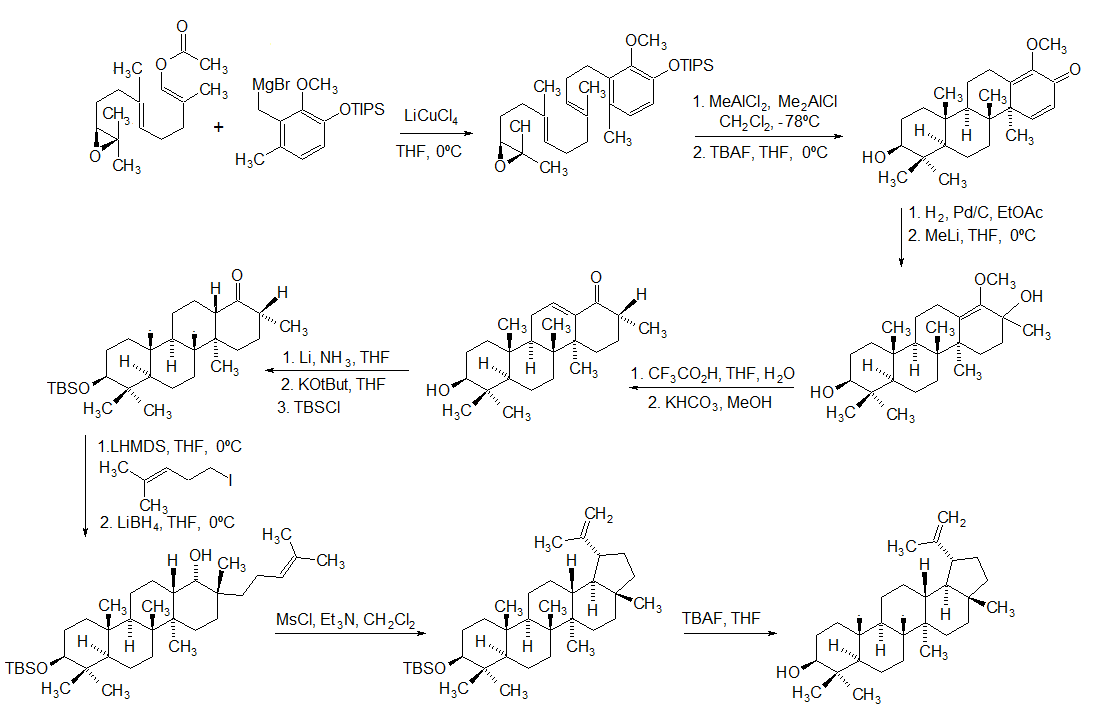Lupeol on:
[Wikipedia]
[Google]
[Amazon]
Lupeol is a pharmacologically active pentacyclic

triterpenoid
Triterpenes are a class of chemical compounds composed of three terpene units with the molecular formula C30H48; they may also be thought of as consisting of six isoprene units. Animals, plants and fungi all produce triterpenes, including squal ...
. It has several potential medicinal properties, like anticancer and anti-inflammatory activity.
Natural occurrences
Lupeol is found in a variety of plants, includingmango
A mango is an edible stone fruit produced by the tropical tree '' Mangifera indica''. It is believed to have originated in the region between northwestern Myanmar, Bangladesh, and northeastern India. ''M. indica'' has been cultivated in Sout ...
, ''Acacia visco
''Parasenegalia visco'' is a perennial tree found at higher elevations in northern Argentina, Bolivia, Chile and Peru. It has also been introduced to Africa. Common names for it include arca, visco, viscote, viscote blanco and viscote negro.
It ...
'' and ''Abronia villosa
''Abronia villosa'' is a species of sand-verbena known by the common names desert sand-verbena and chaparral sand-verbena. It is in the four o'clock plant family (Nyctaginaceae). It is native to sandy areas in the deserts of the southwestern U ...
''. It is also found in dandelion coffee. Lupeol is present as a major component in ''Camellia japonica'' leaf.
Total synthesis
The first total synthesis of lupeol was reported by Gilbert Stork ''et al''. In 2009, Surendra and Corey reported a more efficient and enantioselective total synthesis of lupeol, starting from (''1E,5E'')-8- ''2S'')-3,3-dimethyloxiran-2-yl2,6-dimethylocta-1,5-dienyl acetate by use of a polycyclization.
Biosynthesis
Lupeol is produced by several organisms from squalene epoxide.Dammarane
Dammarane is a tetracyclic triterpene found in sapogenins (forming triterpenoid saponins) like those of ginseng (ginsenoside
Ginsenosides or panaxosides are a class of natural product steroid glycosides and triterpene saponins. Compounds in t ...
and baccharane skeletons are formed as intermediates. The reactions are catalyzed by the enzyme lupeol synthase
Lupeol synthase (, ''LUPI'', ''BPW'', ''RcLUS'') is an enzyme with systematic name ''(3S)-2,3-epoxy-2,3-dihydrosqualene mutase (cyclizing, lupeol-forming)''. This enzyme catalyses the following chemical reaction
: (3S)-2,3-epoxy-2,3-dihydrosquale ...
. A recent study on the metabolomics of ''Camellia japonica'' leaf revealed that lupeol is produced from squalene epoxide where squalene play the role as a precursor.
Pharmacology
Lupeol has a complex pharmacology, displayingantiprotozoal
Antiprotozoal agents ( ATC code: ATC P01) is a class of pharmaceuticals used in treatment of protozoan infection.
A paraphyletic group, protozoans have little in common with each other. For example, ''Entamoeba histolytica'', a unikont eukar ...
, antimicrobial, antiinflammatory, antitumor and chemopreventive properties.
Animal models suggest lupeol may act as an anti-inflammatory agent. A 1998 study found lupeol to decrease paw swelling in rats by 39%, compared to 35% for the standardized control compound indomethacin
Indometacin, also known as indomethacin, is a nonsteroidal anti-inflammatory drug (NSAID) commonly used as a prescription medication to reduce fever, pain, stiffness, and swelling from inflammation. It works by inhibiting the production o ...
.
One study has also found some activity as a Dipeptidyl peptidase-4 inhibitor
Inhibitors of dipeptidyl peptidase 4 (DPP-4 inhibitors or gliptins) are a class of oral hypoglycemics that block the enzyme dipeptidyl peptidase-4 (DPP-4). They can be used to treat diabetes mellitus type 2.
The first agent of the class – si ...
and prolyl oligopeptidase inhibitor at high concentrations (in the millimolar range).
It is an effective inhibitor in laboratory models of prostate
The prostate is both an accessory gland of the male reproductive system and a muscle-driven mechanical switch between urination and ejaculation. It is found only in some mammals. It differs between species anatomically, chemically, and phys ...
and skin cancer
Skin cancers are cancers that arise from the skin. They are due to the development of abnormal cells that have the ability to invade or spread to other parts of the body. There are three main types of skin cancers: basal-cell skin cancer (BCC) ...
s.
As an anti-inflammatory agent, lupeol functions primarily on the interleukin
Interleukins (ILs) are a group of cytokines (secreted proteins and signal molecules) that are expressed and secreted by white blood cells (leukocytes) as well as some other body cells. The human genome encodes more than 50 interleukins and related ...
system. Lupeol to decreases IL-4 (interleukin 4) production by T-helper type 2 cells.
Lupeol has been found to have a contraceptive effect due to its inhibiting effect on the calcium channel of sperm (CatSper).
Lupeol has also been shown to exert anti-angiogenic and anti-cancer effects via the downregulation of TNF-alpha and VEGFR-2.
Famous anti-inflammatory ethno-medicinal plant ''Camellia japonica
''Camellia japonica'', known as common camellia, or Japanese camellia, is a species of flowering plant in the family Theaceae. There are thousands of cultivars of ''C. japonica'' in cultivation, with many colors and forms of flowers. In the U.S. ...
'' contains anti-inflammatory component lupeol in its leaf.
See also
*Betulin
Betulin is an abundant, naturally occurring triterpene. It is commonly isolated from the bark of birch trees. It forms up to 30% of the dry weight of silver birch bark. It is also found in birch sap. ''Inonotus obliquus'' and red alder also conta ...
* Betulinic acid
Betulinic acid is a naturally occurring pentacyclic triterpenoid which has antiretroviral, antimalarial, and anti-inflammatory properties, as well as a more recently discovered potential as an anticancer agent, by inhibition of topoisomerase. It ...
References
{{Reflist Triterpenes Secondary alcohols Total synthesis Cyclopentanes